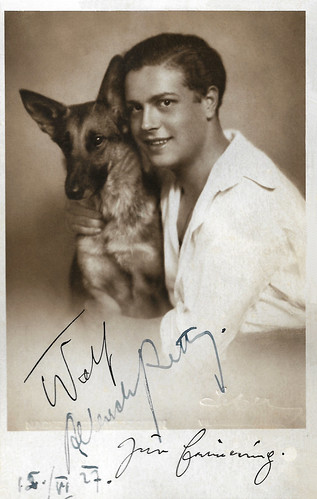
Austrian autograph card, signed in 1927. Photo: Franz Xaver Setzer, Wien.

German postcard by Ross Verlag, no. 9143/2, 1935-1936. Photo: Ondra-Lamac-Film GmbH. Wolf Albach-Retty in Großreinemachen/General Housecleaning (Karel Lamac, 1935).

German postcard by Ross Verlag, no. 9306/1, 1935-1936. Photo: Majestic-Film / Tobis - Rota. Wolf Albach-Retty in Der Vogelhändler/The Bird Seller (E.W. Emo, 1935).
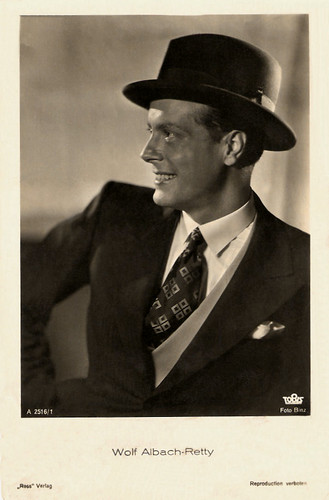
German postcard by Ross Verlag, no. A 2516/1, 1939-1940. Photo: Binz / Tobis.

German postcard by Ross Verlag, no. A 3087/2, 1941-1944. Photo: Baumann / Ufa.

German postcard by Film-Foto-Verlag, no. A 3478/1, 1941-1944. Photo: Baumann / Ufa.
The beautiful adventure
Wolf Albach-Retty was born as Helmuth Walter Wolf Albach in Vienna, Austria-Hungary (now Austria) in 1906. He was the son of officer Karl Albach and actress Rosa Albach-Retty, a star of the Viennese stage. He studied at the Akademie für Musik und Darstellende Kunst (Academy for Music and Performing Arts) in Vienna. When he was 20 he debuted at the famous Burgtheater. He made his first film appearance in the leading role in the silent production Das Grobe Hemd/The Coarse Shirt (Fritz Kaufmann, 1927).
More leading roles followed in silent and early sound films, including Ein Wiener Musikantenmädel/A Vienna Music Girl (1928) and Zwei Herzen und ein Schlag/Two Hearts Beat as One (Wilhelm Thiele, 1932) opposite Lilian Harvey.
In 1932 the Ufa had invited him to come to Berlin. That year he was the male star of Das schöne Abenteuer/The Beautiful Adventure (1932), a romantic comedy by the great director Reinhold Schünzel. Schünzel and Emmerich Preßburger based their script on the French stage play La belle aventure by Gaston Arman de Caillavet, Robert de Flers and Etienne Rey.
Käthe von Nagy stars as the lovely Helene engaged to a corpulent man of wealth (Otto Wallburg). On the wedding day, she runs off with the man she really loves, her cousin André (Wolf Albach-Retty). They stay with her aged grandmother (Adele Sandrock) who assumes André (whom she doesn't know) to be the new husband and has prepared a bridal bed for them.
Schünzel also directed a French version with Roger Le Bon, La belle aventure (1932), starring Käthe von Nagy and Daniel Lecourtois in the role of Albach-Retty. Assistant director Kurt Hoffmann would later direct a remake, Das schöne Abenteuer (1959), with Liselotte Pulver and Robert Graf.

German postcard by Ross Verlag, no. 6884/1, 1931-1932. Photo: Ufa.

German postcard by Ross-Verlag, no. 6979/1, 1931-1932. Photo: Ufa.

German postcard by Ross Verlag, no. 142/2. Photo: Günther Pilz / Ufa. Publicity still for <1>Das schöne Abenteuer/The Beautiful Adventure (1932) with Käthe von Nagy.
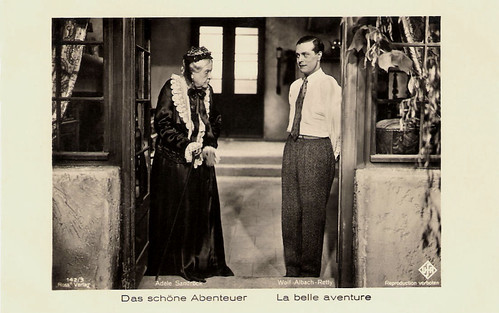
German postcard by Ross Verlag, no. 142/3. Photo: Ufa. Publicity still for Das schöne Abenteuer/Beautiful Adventure (Reinhold Schünzel, 1932) with Adele Sandrock.
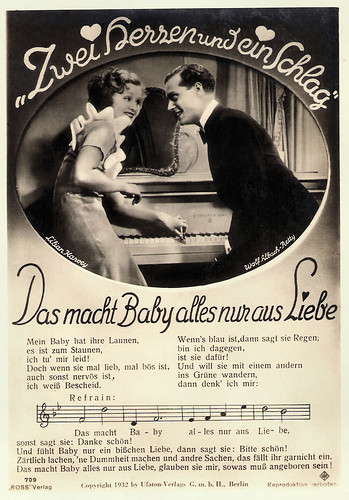
German postcard by Ross Verlag, no. 709. Photo: Ufa. Publicity still for Zwei Herzen und ein Schlag/Two Hearts Beat as One (Wilhelm Thiele, 1932). Collection: Geoffrey Donaldson Institute.

German postcard by Ross Verlag, no. 7202/1, 1932-1933. Photo: Ufa. Wolf Albach-Retty in Der schwarze Husar/The Black Hussar (Gerhard Lamprecht, 1932).

German postcard by Ross Verlag, no. 7203/1, 1932-1933. Photo: Ufa. Ursula Grabley and Wolf Albach-Retty in Der Schwarze HusarThe Black Hussar (Gerhard Lamprecht, 1932).
Romy
Despite his acting talents, Wolf Albach-Retty was mainly seen in commercial entertainment films. During the Nazi years, he mainly performed the romantic lead in superficial musicals and mediocre comedies which pleased the crowds but did not make film history.
Among his most popular films were Liebe muß verstanden sein/Love Must Be Understood (Hans Steinhoff, 1933), the operetta Der Vogelhändler/The Bird Seller (E.W. Emo, 1935) and the comedy Sieben Jahre Pech/Seven Years of Bad Luck (Ernst Marischka, 1940) starring Hans Moser.
In 1940, two years after the 'Anschluss' of Austria to Nazi Germany, Albach-Retty became a party member of the NSDAP.
In 1936 he married the German actress Magda Schneider. The so-called 'dream pair' co-starred in seven films including G'schichten aus dem Wienerwald/Tales from Vienna Woods (Georg Jacoby, 1934) and Winternachtstraum/Winter Night's Dream (Géza von Bolváry, 1935).
Temporarily Albach-Retty became a German citizen during his marriage. He and Schneider divorced in 1946 (some sources say 1945 or 1949). They had two children: Wolf-Dieter (1941) and Rosemarie, who would later become famous as Romy Schneider (1938-1982).
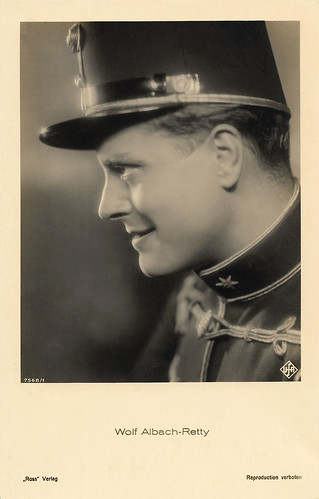
German postcard by Ross Verlag, no. 7568/1, 1932-1933. Photo: Ufa. Wolf Albach-Retty in ...und es leuchtet die Pußta/And the Plains Are Gleaming (Heinz Hille, 1933).

German postcard by Ross Verlag, no. 7851/2, 1932-1933. Photo: Ufa.

German postcard by Ross Verlag, no. 7974/1, 1932-1933. Photo: Ufa. Wolf Albach Retty in Liebe muß verstanden sein/Love Must Be Understood (Hans Steinhoff, 1933).

German postcard by Ross Verlag, no. 8419/1, 1933-1934. Photo: Ufa / Frhr. von Gudenberg.

Dutch postcard, no. 618. Photo: Filma. Franziska Gaal and Wolf Albach-Retty in Frühjahrsparade/Spring Parade (Géza von Bolváry, 1934).

German postcard by Ross Verlag, no. 9055/1, 1934-1935. The photo is a still from Frühjahrsparade (Géza von Bolváry, 1934), also starring Franciska Gaál. The photo was cut out of the card by a former owner. Exception-wise, we've photoshopped new edges.
Back to the Burgtheater
After the war, Wolf Albach-Retty played with his cultivated charm the same kind of romantic roles as before in films like Der Mann, der sich selber sucht/The Man Who Searches For Himself (Géza von Cziffra, 1950) with Vera Molnar, Weh dem, der liebt!/Woe to Him Who Loves (Sándor Szlatinay, 1951) and a remake of Der Vogelhändler/The Bird Seller (Arthur Maria Rabenalt, 1953) opposite Ilse Werner.
But the times had changed. In the late 1950s, his film career started to sour as his past successes were no longer remembered.
His parts became smaller and the films rarer, but he returned successfully to the stage of the Burgtheater in 1959. Till his death, he starred in plays like 'Anatol' by Arthur Schnitzler, which was also adapted for television in 1962 by Otto Schenk.
His last stage role was in 'Professor Bernhardi' by Arthur Schnitzler. His final TV-film was Die Tänzerin Fanny Elßler/Fanny Elßler, the Dancer (Arthur Maria Rabenalt, 1966).
Wolfgang Albach-Retty died in 1967 in his hometown Vienna. He was survived by his second wife, actress Trude Marlen.

German postcard by Ross Verlag, no. 9307/2, 1935-1936. Photo: Atelier Schneider, Berlin.

German postcard by Film-Foto-Verlag, no. G 227, 1941-1944. Photo: Hämmerer / Wien Film.

German postcard by Ross Verlag, no. A 2677/1, 1939-1940. Photo: Binz / Tobis.

German postcard by Film-Foto-Verlag, no. A 3769/1, 1941-1944. Photo: Hämmerer / Wien film.
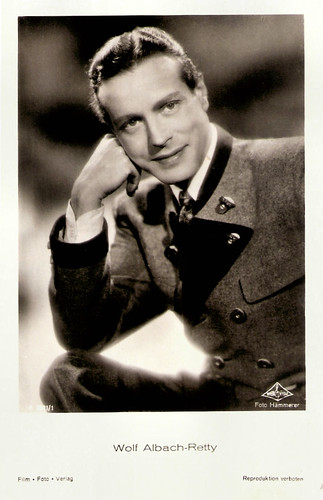
German postcard by Film-Foto-Verlag, no. A 3821/1, 1941-1944. Photo: Hämmerer / Wien Film. From Tatiana.

German postcard by Film-Foto-Verlag, no. A 3585/1, 1941-1944. Photo: Binz, Berlin.
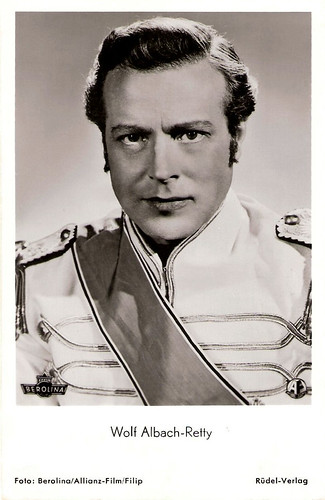
German postcard by Rüdel Verlag. Photo: Berolina / Allianz-Film / Filip.
Sources: Stephanie D'heil (Steffi-line) (German), Thomas Staedeli (Cyranos), Guy Bellinger (IMDb), AllMovie, IMDb and Wikipedia (German).
No comments:
Post a Comment